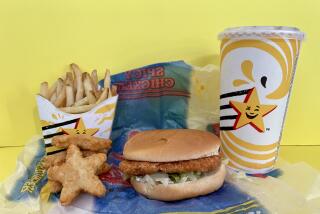Americans may be running up the calorie count when dining out
- Share via
Americans are eating out more and more: According to the National Restaurant Assn., 49% of every food dollar in the U.S. is now spent in restaurants, up from 25% in 1955.
What that means is we have less and less control over just what goes into our food — and the numbers, now available per California law, are sometimes shocking. Even healthful-seeming selections can pack a calorie-, fat-, salt- or sugar-laden punch.
Salads, long touted as a virtuous choice, are a prime example. At IHOP, the grilled chicken Caesar salad has 1,210 calories, far more than the patty melt, which comes in at 750 calories. At Baja Fresh, a chicken tostada has 1,140 calories and 14 grams of saturated fat.
If you figure that the average person needs 2,000 calories a day, it’s sobering to learn that more than half that amount can easily be consumed in a restaurant breakfast alone. And don’t forget sodium. The recommended daily limit is 2,400 milligrams a day (1,500 milligrams for those who are middle-aged, are in certain ethnic groups or have conditions such as high blood pressure). Many restaurant dishes contain more than you should have in a whole day.
Some chain restaurants have begun to create lower-calorie items or are highlighting their existing more-healthful items. Restaurant executives stress that this has been prompted by customer preferences and shifting dining trends, not by existing or pending menu labeling legislation. (Some nutrition experts suspect that new laws and the possible federal mandates waiting in the wings are more influential than companies want to admit.)
The Corner Bakery Cafe recently listed 100-plus combinations of menu items that come in at less than 600 calories, such as an Asian wonton salad and cheddar broccoli soup, or a tuna salad sandwich and Caesar salad.
Applebee’s has its new “Under 550 Calories” menu, offering grilled shrimp and island rice, asiago peppercorn steak, and grilled dijon chicken and portobellos.
Starbucks lately began touting its “skinny” drinks, which are less than 100 calories, such as the skinny vanilla latte and the skinny cinnamon dolce latte, plus its new under-400-calorie hot panini sandwiches.
Cheesecake Factory has a few “weight management” dishes that are lower in fat and calories, and the company recently introduced a small plates and snacks menu, with smaller-portioned items such as mini corn dogs, shrimp scampi crostini, arugula salad and crispy fried cheese — not all of those, however, are low in calories.
Romano’s Macaroni Grill chain was dinged by the consumer advocacy group Center for Science in the Public Interest years ago for its heavy sauces and fatty, meat-centric entrees, but since Chief Executive Brad Blum came on board in 2008, the chain has cleaned up its act.
Yes, the Alfredo is still there (the sauce alone is 610 calories and 31 grams of saturated fat), but so is a honey balsamic chicken at 540 calories and 3 grams of saturated fat (side dishes included) and a scallop and spinach salad at 360 calories and 4 grams of saturated fat that includes the dressing, and pollo caprese pasta at 550 calories and 5 grams of saturated fat. Some favorite dishes have slimmed down: eggplant parmigiana went from 1,270 calories to 800.
It’s not clear what people are doing so far with the information or how that might change when calories and fat grams appear right in your face on the menus in 2011, when the second part of the California law takes effect. Many people, like Elizabeth Rubien, dining on a recent day at Coco’s in Culver City, aren’t very interested.
“I’m not going to study nutritional information when I go into a restaurant,” she said, “and I already know pretty well what’s healthy. I don’t care how many grams of fat are in something. Grams of fat are not my life.”
Kelly Brownell, director of the Rudd Center for Food Policy and Obesity at Yale University, says the same attitude prevailed when food manufacturers put nutrition information on grocery store items, and yet shopping patterns did change with time.
“But the bigger benefit probably will be that restaurants will offer lower-calorie [dishes],” says Michael Jacobson, executive director of the consumer advocacy group Center for Science in the Public Interest. They may also decide to provide meals lower in salt and saturated fat, he says, and trim calories wherever they can from items already on their menus.
More to Read
Eat your way across L.A.
Get our weekly Tasting Notes newsletter for reviews, news and more.
You may occasionally receive promotional content from the Los Angeles Times.










